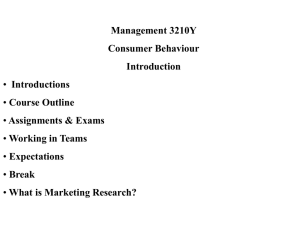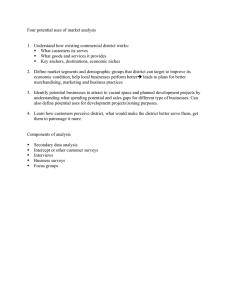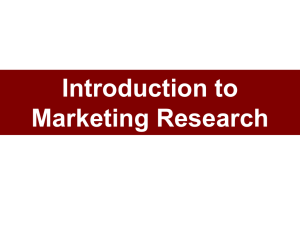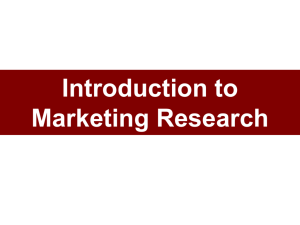What’s in a Number 1? 1’s are: action oriented
advertisement
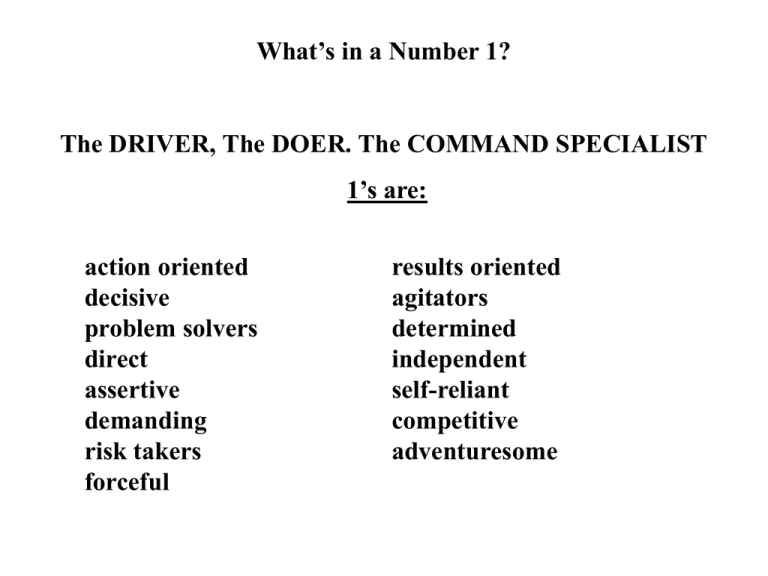
What’s in a Number 1? The DRIVER, The DOER. The COMMAND SPECIALIST 1’s are: action oriented decisive problem solvers direct assertive demanding risk takers forceful results oriented agitators determined independent self-reliant competitive adventuresome When 1’s speak, they: •Are faster and louder •Speak with more statements •Focus on tasks •Use facts and data •Speak in a monotone 1’s display physical qualities such as: •pointing at others •leaning forward to speak •use of direct eye contact •closed hands •rigid posture •controlled facial expression 1’s are recognized by behaviour such as: •reacting quickly •making a great effort to get involved •showing little concern for being cautious in relationships •working in the present time frame •acting directly •a tendency to reject inaction •needing excitement •being personal In order to grow 1’s must LISTEN When a 1 is under stress, they: Become AUTOCRATIC Need POWER On a good day, a 1 is seen as: •Strong willed •Independent •Practical •Decisive •efficient On a bad day, a 1 is seen as: •Pushy •Severe •Tough •Dominating •Harsh 1’s need to learn: •HUMILITY, FEELINGS, LISTENING TO OTHERS, TO FOLLOW • 1s measure progress through results. They are goal-oriented and may run over people to get there •1s must be allowed to know the score, to get competitive situations and win (or appear to win) •1s need leaders that allow them freedom to do things their way •1s always want to save time. As a result, they come across as busy and efficient •1s receive approval and support from getting the job done well and on time •1s are most effective in positions of authority and responsibility •1s rely on the power of their competence. They know they’re strong enough to “wing it” •1s are excellent at jobs that allow them to organize. When a 1 works with another 1: They must first agree in advance on goals, allow each other freedom to work within in agreed upon limits, allow each other to wine and be in charge When a 1 works with a 2: The 1 must be more open about him/herself and his/her emotions, relax time constrictions, give 2s, incentives, let the 2 win, provide the 2 with public recognition, loosen up, play. When a 1 works with a 3: The 1 should show personal concern for the 3, provide the 3 with details and specifics, acknowledge the 3s contributions, be supportive of 3’s efforts and accomplishments, build a relationship. When a 1 works with a 4: bring facts and logic in writing, be patient while the 4 evaluates, assist a 4 in coming to decision, work with the time limits. WHAT IS MARKETING RESEARCH? Marketing A process of planning and executing the conception, pricing, promotion, and distribution of ideas, goods and services to create exchanges that satisfy individual and organizational objectives. The Marketing Concept The whole of the organisation should be driven by a goal of serving and satisfying customers in a manner which enables the organisation’s financial and strategic objectives to be achieved. What is Research? MARKET RESEARCH The Systematic and Objective identification, collection, analysis and dissemination of information about markets, organizations and people undertaken to improve decision making related to identifying and solving problems (also known as opportunities) in marketing. Why do Organizations Need Market Research? Knowledge is power •reduce the uncertainty in the decision-making process •increase the probability and magnitude of success. •better understand their customers. •marketing budget is effectively targeted and well spent. •development of new products •help to determine the most appropriate and profitable launch program •to gain an understanding of the competition •target new markets or business opportunities Bottom Line: Profits and Shareholder Value What sort of information is needed – generally? A ccurate “It ain’t the things we don’t know that gets us in trouble. It’s the things we know that ain’t so.” Artemus Ward R elevant “ When a man does not know what he is Seeking, no wind is the right one” Seneca Timely We are in the information age - timely information has tremendous value What sort of decisions does management face that require information (i.e. Marketing research) Product Oreo conducts taste test, Oreo cookie vs. Chips Ahoy Price Safeway does a competitive pricing analysis Promotion How many consumers recall the “Life Tastes Good. Coca Cola!” slogan? Place Caterpillar Tractor Co. investigates dealer service program. What are the Major Sources of Information? • • • • Marketing Research Customer Databases Internal Reporting Systems/ Scanner Data The Internet / On-line Sources What are Two main sources of information? – Secondary Research • Existing studies, census data, articles • Internet, library, trade journals – Primary Research • Create your own questions • Find your own answers by asking people what they think, feel, know, etc. • Common methods include: – Focus groups, surveys What are the Two main types of information? – Qualitative • “How do people feel about the color purple?” • Not predictive of market behavior • Qualify needs, wants, preferences • Focus Groups, In-depth interviews – Quantitative • “How many people like the color purple?” • Predictive if done correctly • Surveys: Telephone, Mail, Intercept, Internet In February 2002 the Alberta Liquor and Gaming Commission, lifted the moratorium on new casinos in Alberta. What sort of market research projects might be of value to a company thinking of opening a new casino in Calgary. Applied Marketing Research Example • Should McDonalds add Italian pasta dinners to its menu? • Marketing research told McDonald’s it should not? • Should Procter & Gamble add a high-priced home teeth bleaching kit to its product line? • Research showed Crest Whitestrips would sell well at a retail price of $44 Analyze Marketing Performance • This year’s market share is compared to last year’s. • Did brand image change after new advertising? Determining When to Conduct Marketing Research • • • • Time constraints Availability of data Nature of the decision Benefits versus costs Anecdotal evidence suggests that although customers like the performance and comfort of the Ford Crown Victoria. They are not overly enthusiastic about it’s design, however. Ford has decided to hire an external market research company (i.e. you) to find out how the public are likely to feel about a new design. What steps would you take to provide this information? Would you talk only to men? Would you talk only to current owners? Would you talk to only 10 people? Would it matter if you asked them about Ford Escalade? Would it matter if did a multiple regression analysis? Marketing research works because, by talking to a relatively small number of people, it is possible to find out about a far larger number. But….. it only works if you talk to the right number of people, it only works if you talk to the right type of people and it only works if you ask the right questions and analyse the data you get in the right way. The Marketing Research Process • • • • • • Problem identification specifying what information is required; designing the method for collecting information; managing and implementing the collection of data; analyzing the results; and communicating the findings and their implications. Alice: “WOULD YOU PLEASE TELL ME WHICH WAY I OUGHT TO GO FROM HERE?” Cheshire Cat: “THAT DEPENDS ON WHERE YOU WANT TO GO” Lewis Carroll The Marketing Problem versus the Marketing Research Problem A distinction must be made between the management problem and the marketing research problem. Management Problem Marketing Research Problems • Focus on symptoms • Focus on causes • Action oriented • Data oriented Getting Started • Methods – Use a mix of methods – Start with Secondary research – Use Primary research to fill in specific gaps – Mix qualitative & quantitative • Gathering Data – DIY – Outsource Which Methods Work Best? •Focus Groups – Explore how people feel about your concept and why they feel that way. – Show concepts, get immediate feedback – Change questions on the fly – 4-10 people make a group – Recruit the right people - offer an incentive – 1.5 to 2 hours on average – Audio/video recording Which Methods Work Best? Observational Research (Ethnography) – Roots in anthropology - observe people doing things in specific environments. – Record observations - video, paper, audio – Quantify observations to analyze – Enrich information with understanding of why people do what they do - ask them. Which Methods Work Best? Surveys – Mail, telephone, intercept, internet – Establish measures of awareness, quality, service, market share – Predict how many people will buy “x” – Statistically valid findings if... Rules for Predictability • Sample must be chosen at random from defined population • Sample size determines confidence in data • More confidence = more predictable – n 100 = 90% ±5 – n 400 = 95%±5 – n >1,000 = 98% ±3
